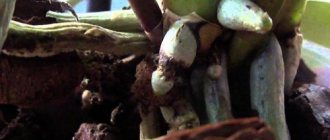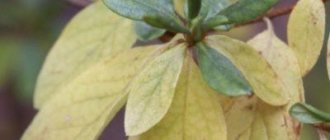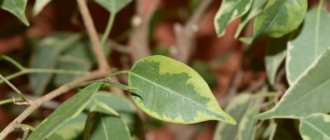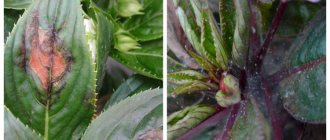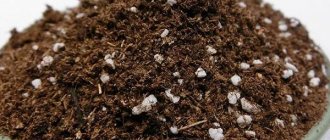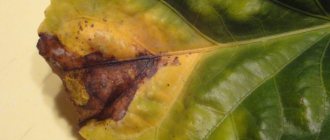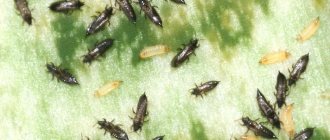Let's look at the main diseases of cacti and their treatment. Most often, cacti are affected by spider mites, various rots, viral infections, and the stem becomes covered with brown spots. The cactus rots due to waterlogging of the soil, in some cases it is a fungal infection, spotting is also a consequence of waterlogging of the soil in the pot, but it is also caused by viruses. Brown spots are the result of a burn or viral infection of the stem. Spider mites are the result of dry air and insufficient watering.
So, diseases of cacti and their treatment with photos and detailed explanations from specialists. What to do if the cactus is rotting, spotted or yellow?
Treatment of wet and dry rot
Perhaps the most dangerous enemy of a cactus is rot. Rot is caused by microorganisms and can manifest itself in a wide variety of forms. Basically, there are two types of this disease:
- Wet rot
- Dry rot
Of course, it cannot be argued that such a classification comes from biological terms. Nevertheless, it most functionally and very qualitatively reflects the essence of the situation that has arisen.
In most cases, the spots look like white cotton wool or sticky whitish mold .
The most common problem that occurs, especially among novice cactus growers, is root rotting. In the article about proper watering of a cactus , we examined in detail all the nuances and subtleties associated with moistening the soil in a pot.
The topic of proper watering of succulents is a completely different story. It is incorrect watering, with serious mistakes, that leads to such disastrous, terrible results. This is the most common reason that leads to the complete death of a prickly pet.
The main problem with root rot in a plant is that the roots in the ground , in fact, simply begin to decompose. At the same time, the ongoing processes poison the entire soil around the cactus with secretions. It is the dead part of the roots, which decomposes due to the work of microorganisms, and is the main focus and source of all kinds of pathogenic agents of various types of rot.
Of course, all these processes do not happen instantly. They require some time. It is precisely during this time period that you can try to save the succulent.
Of course, the most correct, simple and effective way would be to prevent these situations from occurring. The main thing is to try at any cost to stop the negative processes that have already begun. Next, it is necessary to urgently take all necessary measures to save the plant. Return and place the prickly pet in the correct, comfortable and most suitable conditions of detention.
The main signs that simply must alert the attention of a cactus grower:
- Your favorite cactus has begun to grow much slower than usual
- The cactus stopped gaining turgor after watering. The point is that the succulent does not gain the usual elasticity and density of the main stem after storing moisture during watering.
Types of mold: white, efflorescence
On the surface of the soil in a flower pot there are most often two types of fungi:
- white - very similar to fluff and easy to rub in your hands;
- efflorescence - this crystalline coating can be white, gray or green.
Efflorescence is more dangerous, since this coating develops not only on the surface of the soil, but can also affect the interior of the soil.
How can it harm the plant?
In addition to the fact that white coating spoils the aesthetic appearance of the soil and infects it with fungal spores, it also affects the plant itself.
White deposits on the soil surface can lead to the following consequences :
- the flower will stop developing;
- access to oxygen will decrease and the roots will no longer receive nutrients;
- the acidity of the soil will be disrupted and the mineral composition of the soil will change;
- pets can get fungal diseases and die;
- Most often, the plant begins to shed its leaves due to a lack of nutrients in the soil.
How to cure a cactus from rot
If the root system of the cactus feels good, it makes sense to transplant the plant into a new container with fresh soil. Perhaps even slightly increase the size of the new pot .
If there are serious concerns about pests in the soil , then it is necessary to make water baths. That is, the roots of the plant must be completely washed from the old soil.
Only after this procedure, transplant the plant into new soil. This operation must be carried out as carefully as possible, avoiding damage to the small roots.
Unfortunately, in most cases of root rot, cacti have practically no living roots. From the root system, often only one name remains. Instead of healthy, white, strong roots, you can only see small, thin whitish threads with an unhealthy tint. In some places, they also begin to rot and decompose.
When treating a cactus for root rot, all dead roots must be removed.
Prevention measures and methods of getting rid of mold
To stop the formation of fungal plaque in the pot, it is recommended to reduce the volume of water for watering the plant and the frequency of the procedure. To quickly evaporate excess moisture, you can carefully loosen the substrate around it so as not to damage the roots of the flower. It should be remembered that improper care can lead to the development of infection both in anthurium, which requires a lot of moisture, and in cactus, which is unpretentious. Having found out why there is mold in a flower pot, we can come to the conclusion that its appearance does not depend on the condition of the plant, but on external factors.
Rot on a cactus stem
No less rare is wet rot on the main stem of a cactus. It is much more noticeable. Unfortunately, it also happens faster. Externally, it looks like a large wet, black spot. Sometimes it has a brownish tint. May often appear pure brown in color.
Unfortunately, this problem becomes very visible only when a significant part of the surface of the succulent is already affected.
If you find similar signs on your cactus, then all these lesions must be cut out to a clean section of the stem. You need to get to the place where the lesion is completely absent. After cutting and removing, there should be living, healthy plant tissue everywhere.
If the places in need of rot removal were minor, then the plant will cope with it quite easily and the damage will quickly overgrow. However, ugly scars will remain on the cactus for a very long time, in especially advanced cases - forever.
It is worth noting that in the case of serious amputations of significant parts of the plant, the cactus can be deformed to a frankly ugly shape and remain that way for many years.
Spider mite
Almost all flower growers who have large collections of home flowers encounter this “comrade” sooner or later. It is enough for a mite to infest itself on one specimen and soon all the plants find themselves entangled in its thinnest web.
Most often, the parasite grows on indoor plants in conditions of increased dryness and air temperature; spider mites really like such conditions.
He is a polyphagist and is not particularly picky in choosing a plant, however, he prefers succulents with a fleshy and juicy aerial part. The mite pierces the skin and sucks out their vital juices. It is much easier to detect the parasite on such specimens than on ordinary indoor flowers.
Signs of infection
Spider mites are tiny insects, the size of which does not exceed ¼ mm. It is quite slow, but at the same time has a fantastic reproduction rate. After just a couple of days, a colony of mites colonizes almost all surfaces of the succulent, and multiple yellow or brownish spots appear on the affected areas. The skin of cacti damaged by these insects is not restored.
Gradually the size of the spots increases, they merge, and the foliage dries out. The plant is almost completely covered with cobwebs; at the tips of the leaves and shoots you can see a moving mass consisting of tiny mites. The growth of the succulent slows down, the buds wither and fall off.
Dry rot on a cactus
Another disease is no less dangerous - dry rot on a cactus. With this disease, there is no rot as such. That is, rotting and decomposition does not occur and is not even observed. However, externally the plant begins to dry out from the inside and externally changes its shape. In some severe cases, the color of the stem also changes.
What is surprising is that the plant becomes dry inside. That is why this disease received such a fancy name.
Unfortunately, these processes proceed very, very quickly. The worst thing is that this disease simply does not have an initial period. The problem becomes obvious only when time has already passed and it is almost impossible to do anything.
The nature of this disease is practically not studied. Very little is known about him. That is why there are no effective treatment methods or ways to save plants.
The most appropriate solution is prevention. We can only talk about preventing the occurrence and development of this disease. Of course, the key to successful prevention will be compliance with all necessary conditions of maintenance and creation of maximum comfort for the succulent.
However, no one has yet canceled the treatment of diseased plants with fungicidal preparations. It is simply pointless to dispute their high efficiency. They work extremely effectively against most fungal pathogens.
I would also like to note that preventive spraying with fungicides also gives excellent results in preventing the occurrence of diseases caused by various fungi.
Quite often, rot makes itself felt on young crops of seedlings . Cactus crops are a high-risk area. To prevent such situations, it is necessary to dry all crops for at least two or three days. Interestingly, exposure to direct sunlight or exposure to ultraviolet light is also very effective in combating this disease.
Thus, to summarize, the most effective methods for combating dry rot are:
- UV treatment or exposure to direct sunlight
- Drying young crops, preventing excessive waterlogging of the soil
What it is?
The cactus is covered with white spots or dots similar to granulated sugar - this is the main symptom of an attack by a pest such as mealybug.
- the parasite has an oblong, slightly oval body, its length reaches 5 mm;
- the color is grayish with white fibers throughout the body;
- the main damage to the plant is caused by females and larvae of insects;
- an additional sign of mealybug infestation is a thin white web enveloping the cactus;
- Sooty fungus may develop in parallel (the pest carries its spores).
There may be several reasons for a parasite becoming infected on a cactus . The most common ways are improper care, infection from a neighboring plant, or penetration through contaminated soil.
Below you can see a photo of the affected areas with mealybug, which looks like mold.
How does rot occur on a cactus?
How do rot pathogens get into plants? The answer to this question is quite simple. The main reason for the penetration of pathogenic microorganisms is damage to the integument of the plant stem. In some cases, damaged areas on the roots. Many varieties of pathogens can easily live inside the plant and be carried within the stem, causing massive, widespread destruction. Naturally, the most serious consequences will be in vulnerable places, not weakened specimens.
Remember - it is easier to prevent than to try to cure later.
Factors contributing to mold formation
The main reason for the appearance of white plaque on the soil is a fungal infection. There are several conditions necessary for its development. Mold in a flower pot is formed due to low temperature, high humidity in the room, and improper watering (excessive or frequent). Clogged drainage holes at the bottom of the plant container and a substrate that does not match the type of planting also contribute to the development of fungus.
Mold in a flower pot often appears when cloudy autumn days arrive. During this period, plants absorb less water, and that which remains in the ground due to lower air temperatures evaporates slowly. As moisture accumulates, it creates favorable conditions for the development of infection.
How to treat cacti from spotting
No less rare is the so-called spotting of cacti. It is rather weak and little studied. In general, it does not occur often. Spots and their types are very difficult to recognize, much less distinguish between each other. Especially if you are a beginner cactus grower - an amateur. This task is very difficult even for an experienced succulent plant collector who has been cultivating cacti for 10-20 years!
Spots are caused by pathogens and viruses. A very important fact should be taken into account here. In the vast majority of cases, only weakened plants are affected. That is, again, we return to the basics - prevention. The key factor to prevent the development of these diseases is to keep the plant in the most comfortable conditions for it.
Rust colored stains
Rusty-colored spots on the cactus appear mainly due to hypothermia. The plant was probably exposed to low temperatures for too long. It is also possible that the required temperature does not correspond to the current time of year . In these cases, the stains are even browner and darker in color than rust. The brownish color of the spots clearly indicates that the plant is in extremely low temperatures. It is unacceptable.
Rust on a cactus stem can also signal increased air humidity. Remember, cacti are desert dwellers . There is no humid air there. These plants prefer and need dry ambient air space. In addition, increased humidity in the air stimulates the development and activity of most pathogenic fungal diseases.
Sometimes, rust spots may appear with small growths and mosaic patterns. There are also cases with “depressed” spots on the main main stem. Removing these spots surgically often does not lead to the expected results. Very often the plant cannot be saved.
How to treat cactus spotting
There are a huge number of folk remedies and methods. However, from our point of view, the vast majority of them are ineffective. The saddest thing is that the effect is achieved only partially and temporarily, and after that the disease progresses and the result is disastrous.
A much more effective way to combat this disease is professional “chemistry” - fungicidal preparations. Spraying with fungicides gives the most noticeable and effective results. Also, it is equally important to move the cactus to a more suitable place for the period of treatment. It is vitally important to provide the prickly friend with the most suitable cultivation conditions for it.
If the disease has affected the ampelous type of succulent, then partial removal of the affected shoots must be done.
Diseases resulting from improper care of succulents
This type of disease includes burns (chemical and solar), frostbite of the plant, overwatering, excess or deficiency of nitrogen or phosphorus, alkalization of the soil, etc.
Sunburn
White, pale yellow or brown spots that appear and do not heal for a long time on a succulent are the first signs of sunburn. As a rule, these types of burns appear in the spring, when pots of cacti are often exposed to bright sunlight after winter. It is impossible to cure such diseases. Do not forget to shade the flowers when you take them outside or place them on the windowsill.
Chemical burns
If the concentration of chemicals is too high, the succulent can get a chemical burn. This leads to leaves falling off. Always read package instructions carefully before using chemicals. It is better to reduce the dosage of the drug to avoid burns.
Plant frostbite
Succulents and cacti have different tissues from regular plants. Thick leaves and stems store a lot of water. Frost damage causes massive damage to cells inside the plant. However, many of these plants are surprisingly hardy. At first it is quite difficult to understand that the crops have been damaged, but after 3-5 days the shade of the stems changes, they become black, and then they dry out. The tissues of the crops turn glassy and transparent. The reason for this is frostbite, which happens even with frost-resistant varieties. Also, similar phenomena are typical for crops that have been exposed to through winds.
Photo of frostbitten cactus
If the leaves become soft and black at the base and come off easily, the plant is dead and should be removed. In case of partial frostbite, the plant can be saved by gradually increasing the temperature of the environment. First of all, it is recommended to abandon fertilizers and limit watering in order to fully prepare the crop for the wintering process. Using ventilation, it will be possible to establish the optimal temperature regime in an apartment or greenhouse. The main preventive measure is to become familiar with the temperature requirements that a particular crop prefers.
Chemotherapy method
Chemotherapy is the use of drugs that have a damaging effect on tumor tissue. Most often, it is a component of complex treatment and is used as an addition to the surgical treatment method, expanding its capabilities. For some malignant tumors, in particular hematological malignancies, chemotherapy is used as the main and often the only method of treatment. The chemosensitivity of tumor cells largely depends on the characteristics of their proliferation. Actively dividing cells are most sensitive to antitumor effects, while temporarily or permanently resting cells are not sensitive to them. Therefore, slowly growing, highly differentiated neoplasms are little sensitive to chemotherapeutic effects. The effectiveness of antitumor drugs largely depends on the mode of its use (dose, rhythm). The choice of chemotherapy drugs, optimal doses and intervals between administrations is determined by their pharmacokinetics, the histological structure of the tumor, its location, as well as the individual characteristics of the body.
Modern clinical chemotherapy is based on the use of repeated courses of combinations of anticancer drugs.
Dosing of chemotherapy drugs
The dosage of each chemotherapy drug must be selected so that the drug has a cytotoxic effect on tumor cells, while causing minimal damage to healthy tissue cells. As a rule, medical dosages are not applicable to animals, this is primarily due to the inability to control severe toxicoses and side effects caused by high dosages. The dosage of most chemotherapy drugs is based on body surface area rather than weight. This is because blood flow through internal organs, primarily the liver and kidneys, depends more on body surface area than on weight.
Dependence of body surface area on weight
Complications of chemotherapy
The clinician should be acutely aware of the potential toxicity of chemotherapy drugs, especially for patients with underlying medical conditions, and closely monitor the progress of treatment. To do this, before starting treatment, it is necessary to assess the condition of the internal organs, primarily the heart of the liver and kidneys, the state of hematopoiesis, the levels of hemoglobin, red blood cells, leukocytes, and lymphocytes. In practice, immediately before a course of chemotherapy, it is necessary to conduct hematological and biochemical blood tests and take a cardiogram. In the future, to monitor possible complications and timely relief of side effects, it is necessary to conduct a hematological analysis once a week, and a biochemical analysis - once every three to four weeks. Due to the fact that chemotherapy drugs have a low selectivity of action and damage any rapidly growing tissue, complications are most often observed in organs and tissues containing a large number of dividing cells.
Immediately after the administration of chemotherapy drugs, the most common complication is vomiting. It is most common after the administration of platinum drugs and doxorubicin. In most cases, vomiting can be controlled by pre-administration of antiemetic drugs (cerucal, torecan, ondansetron and novoban) in combination with corticosteroids, as well as by reducing the rate of infusion of chemotherapy drugs.
The next most common complication is diarrhea. To relieve this complication, it is necessary to prescribe antispasmodics, bismuth preparations, antibiotics and infusion therapy. The most common complication, inherent to one degree or another in all cytostatics (with the exception of vincristine and bleomycetin), occurs a few days after drug administration - myelosuppression. This is due to the fact that chemotherapy drugs attack the bone marrow. All precursors of leukocytes, platelets and red blood cells can be suppressed, resulting in leukopenia, thrombocytopenia and anemia. The main consequences of severe granulocytopenia are the risk of infectious complications. Therefore, when granulocytes decrease to less than 3 - 4 thousand per ml, it is necessary to prescribe broad-spectrum antibiotics. Anemia is combated by prescribing iron supplements and erythropoietins. In practice, after a cycle of chemotherapy, infusion therapy is carried out for 5 - 7 days, and hematological parameters are monitored, which helps prevent the occurrence of acute complications.
Popular articles What varieties of roses can be planted in a shady rose garden
Diseases caused by disturbances in metabolic and other physiological processes.
This group of diseases includes diseases that are not infectious in nature, but are caused by disruption of metabolic and other physiological processes in the plant. The main diseases of this group are: chlorosis, etiolation, deficiency or excess of a number of macro- and microelements, vitamins, and so on.
External signs.
Etiolation . Occurs when the cactus is insufficiently provided with lighting. The cactus becomes discolored and its stem becomes elongated.
Lack or excess of micro- and macroelements:
- lack of nitrogen leads to inhibition of stem growth;
- lack of fluorine leads to inhibition, decreased nitrogen absorption, disruption of photosynthesis and respiration;
- lack of sulfur leads to the death of vascular bundles, the formation of reddish spots of dead tissue in the apical zone;
- lack of calcium leads to decreased root growth and the formation of root hairs;
- lack of potassium leads to chlorosis;
- a lack of magnesium leads to a delay in flowering, pale color of the flower, and chlorosis of tissue in the root collar area;
- lack of iron leads to chlorosis, death of the growing point and areolar meristem, and falling of buds;
- lack of manganese leads to inhibition of growth and respiration processes;
- lack of zinc leads to excessive babying;
- lack of copper, molybdenum. boron, chlorine, iodine: leads to growth inhibition.
Treatment and prevention.
Compliance with the rules for keeping cacti - lighting level, temperature and watering regime, precise dosage of fertilizing, its timeliness, selection of soil necessary for cacti.
Causes of psychosomatic diseases
Psychosomatic diseases are classified as somatic. Psychological factors play a significant role in their appearance and progression. These diseases arise only in the presence of specific personality traits. And they are caused by anxiety, fear, conflicts, anger, dissatisfaction and other types of affective tension.
The deterioration of the psychological microclimate, which entails the emergence of negative psychological factors, can cause migraines, malignant tumors, endocrine disorders and a number of other diseases. Therefore, it is necessary to clearly distinguish between diseases that require psychopharmacology and psychotherapy as treatment, and diseases that have similar causes but require other treatment methods.
Psychological stress can cause organic diseases: bronchial asthma, myocardial infarction, neurodermatitis, ulcerative colitis, stomach ulcers, hypertension, and so on. Among doctors, these diseases have received the common name “Major psychosomatic diseases.” This once again proves the dominant role of psychogenic factors in the onset of the disease, and also emphasizes its severity both from the point of view of its course and from the point of view of treatment.
Psychosomatic diseases have a number of similar features, among which are the following:
- Mental stress plays a major role in the occurrence of diseases;
- Diseases become recurrent or chronic after manifestation;
- Adolescents are most often susceptible to psychosomatic illnesses, but the first manifestation of the disease can occur at absolutely any age.
Serious long-term psychotraumas, internal conflicts caused by multidirectional motives of the same intensity, leading to internal conflict, often become the cause of psychosomatic diseases. For example, hypertension most often occurs in people who are subject to internal conflict between an unfulfilled need for power and high-level behavioral control. This conflict leads to constant aggressiveness. Because of its occurrence, this disease is similar to neuroses, which are also based on personal conflicts. However, with a psychosomatic illness, a more significant double repression occurs - a combination of neurotic anxiety and an unacceptable motive. As a result, a person’s consciousness admits defeat, a kind of capitulation, which becomes a prerequisite for disguised depression, and even later – for psychosomatic diseases.
Historically, only 7 diseases are classified as psychosomatic, each of which significantly worsens the quality of life and affects certain organs and systems. This list includes: rheumatoid arthritis, thyrotoxicosis, neurodermatitis, ulcerative colitis, bronchial asthma, peptic ulcer, essential hypertension.
How to resuscitate when a flower is completely damaged?
It also happens that people go on vacation, entrusting their “green hedgehog” to the care of a neighbor, and upon returning they find their pet in a terrible state, rotten to the very top.
What are the chances of rehabilitation?
If most of the plant has undergone rotting processes, it is impossible to revive it; such a cactus simply does not have enough strength to take root.
If the top has survived, you can try to root it. For this:
- the healthy part is cut off and dried in an upright position for several days;
- the cut site must be treated with coal or sulfur;
- then the surviving part is planted in dry soil with infrequent watering until roots appear.
The cactus cannot be called capricious, but it also requires care and attention from the gardener. Read articles from our experts about why the plant turns yellow, stretches out or leans to the side, and also how to rid the flower of white bloom.
Pests
The cactus may break, dry out or darken due to harmful insects. Let's look at the most dangerous of them.
Mealbug
Mealybugs are small insects covered with fine white hair. They quickly move from plant to plant.
These pests feed on succulent sap. In addition, a sooty fungus settles on their secretions. The affected plant begins to wither and lag behind in development, new shoots may decrease.
The cactus needs to be treated with a soap-alcohol solution (1 teaspoon of soap and 2 tablespoons of alcohol per 1 liter of water) to remove the protective coating on the parasites. Then visible insects need to be removed with a cotton swab and, finally, the cactus should be sprayed with an insecticide (Fitoverm, Aktara, etc.).
Spider mite
Typically, ticks start due to too hot, dry air. Most often, fleshy varieties suffer from it: rebutia, echinopsis, etc.
These tiny (up to 0.25 mm) insects pierce the skin of the plant to feed on its sap. The damaged areas dry out and turn yellow, gradually merging into a brown shiny spot. The top suffers the most.
The cactus should be treated with Karbofos, an ether sulfonate solution or a decoction of cyclamen tubers. You can also wipe the plant with soapy water, alcohol or garlic infusion.
Since many products will only kill larvae or adult ticks, treatments must be carried out several times.
Nutritional diseases
In industrial aquaculture with the transition to highly intensive forms of fish farming (in cages, pools, etc.), nutritional diseases cause damage. They are divided into 2 groups. The first includes diseases associated with the use of unbalanced feed in terms of fat, protein, carbohydrate, mineral and vitamin composition. The second group includes diseases that occur in fish as a result of consuming low-quality feed, contaminated with microorganisms (bacteria or fungi), their metabolic products, or containing oxidized fats. Nutritional diseases occur in fish of different species and ages. They reduce the growth rate of fish and can cause their death. The peculiarities of their manifestation require not only general, but also special approaches to their prevention.
